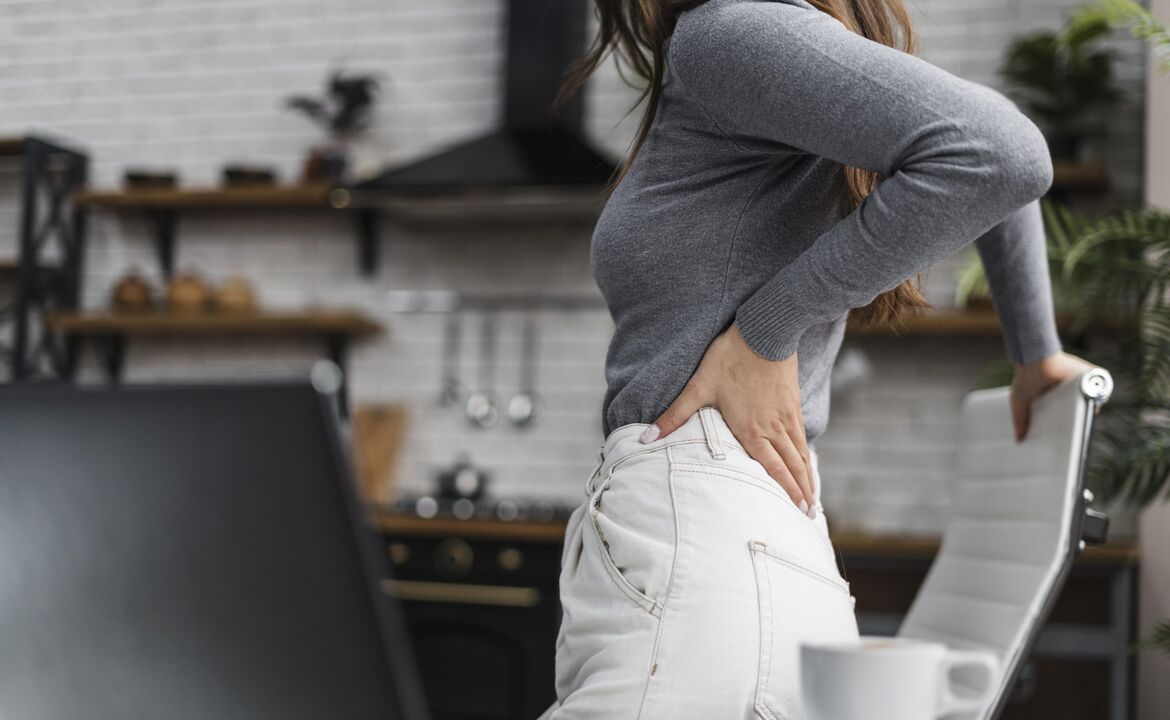
Back pain in the lumbar region can indicate various diseases of the spine, connection disorders of nerve structures, damage to internal organs, soft tissues and cancerous tumors. Pain syndromes can vary in intensity and nature of presentation. Depending on the type of pain that occurs, pathology can be determined, but to obtain an accurate diagnosis, an examination will be performed, including instrumental diagnosis. This allows you to find out why the pain occurs. Based on the examination results, the doctor chooses a treatment method.
Types of pain
Back pain in the lumbar region can indicate the development of serious pathologies. But in most cases, discomfort is benign and is related to the influence of various external factors:
- Hypothermia;
- staying in an uncomfortable position for a long time;
- compression of blood vessels;
- soft tissue damage due to trauma.
When diagnosing back pain, the doctor pays attention to the nature of its manifestation and duration. If the pain occurs due to a cold or simply hypothermia, it will completely disappear 2 weeks after using ointments containing non-steroidal anti-inflammatory ingredients. They will not help cure the disease, but moving afterwards is not painful.
If the pain in the spine does not improve despite the use of topical medications and sometimes becomes worse, a comprehensive examination is needed. In some cases, such symptoms are alarming signs indicating the development of dangerous diseases. With spinal diseases, when attacked, pain can spread to many different areas of the body: legs, arms, groin. Usually, such an attack is accompanied by unpleasant sensations in the body: numbness, tingling, goosebumps, burning.
In most cases, pain in the lower back occurs suddenly, is acute, and resembles lumbago. Patients themselves describe the pain as shooting, sharp, sometimes squeezing and less intense. At the moment of attack, a person's movements are limited and it is possible to straighten the lower back only with pain. Movements do not bring relief and sometimes cause increased pain. The acute condition may last only a few minutes, but sometimes it lasts a day or more.
Women and men over 50 years old, as well as people with severe injuries, experience chronic pain in the lower back. In this case, the situation is persistent but acceptable; Patients only feel mild discomfort, stiffness in the morning and pain at night. Chronic pain can be triggered by stress, heavy lifting, or hypothermia. The rest of the time there is no pain, there is a feeling of stiffness and discomfort.
Lower back pain in pregnant women
Women often experience lower back pain during pregnancy. Its appearance is associated with natural changes. As the fetus grows, around the second trimester of pregnancy, the center of gravity changes, causing posture deformation with deviation in the lumbar region. This change is not dangerous, occurring suddenly in more than 70% of women, but needs to be monitored because it can lead to serious health problems later.
During pregnancy, no special treatment is performed. To reduce the intensity of pain, a doctor may advise a woman to take topical NSAIDs. In some cases, it is recommended to wear support structures to ensure proper load distribution on the spine.
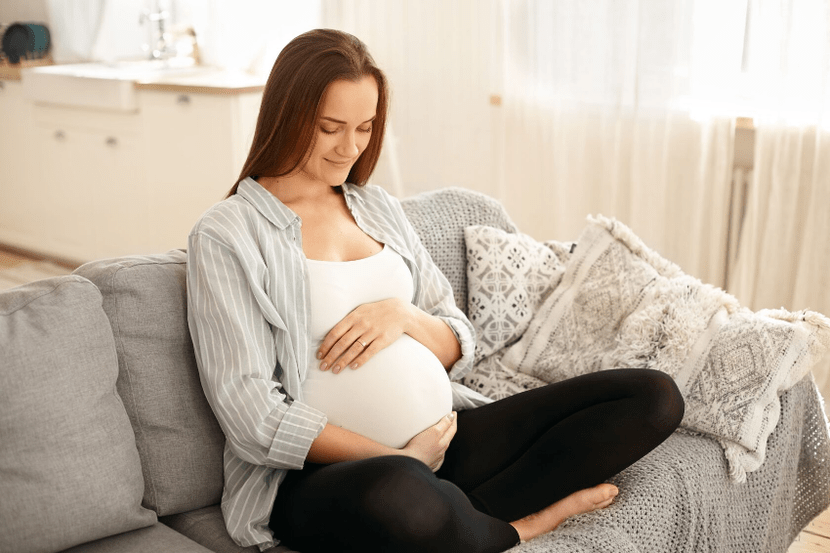
In addition, expectant mothers should not ignore the general rules, they must rest regularly and avoid wearing high heels. Be careful when bending down to pick something up. Straighten your back and stand up straight, then you need to get up as slowly as possible. You should also pay attention to choosing a bed at home, it should be comfortable.
Pain at night and morning
If severe discomfort bothers a person mainly at night and occurs in the morning immediately after waking up, the problem that should be sought is the quality of sleep at night. The manifestation of severe pain is associated with incorrect body posture at night during rest. The first thing you need to do at home is change the mattress, bed, and pillows. It would be better if the bed was orthopedic.
If the pain appears only in the morning, then the possibility of making sudden movements after waking up should be considered. It's better to wake up earlier and gently warm up your muscles and joints while lying in bed. When you regularly perform such exercises, you can forget about the manifestations of pain. Bending over will be much easier and the feeling of back stiffness will disappear. It will be easier to stand up after a warm-up.
It is also important to note that the spine and lower back have to bear excess body weight. The problem of back pain often occurs in obese people, as well as in patients with a sedentary lifestyle. After normalization of behavior and improvement of night sleep quality, periodic pain will disappear if not associated with any disease.
Lower back pain radiating to the legs
Pain that occurs in the back can spread throughout the body. Usually, it spreads down the leg and can affect part of the foot and up to the heel. The cause of pain is sciatica, lumbago or radiculitis, that is, pathologies associated with damage to nerve tissue. Due to changes in the structure of cartilage tissue, it leads to deformation of the vertebrae and the formation of bone spurs, compression of nerve endings, and throbbing pain that spreads down the legs.
Deep pain
The duration of acute pain attacks varies. They can last from a few minutes to many weeks. Chronic pain can manifest itself unnoticed and clearly for a person, the patient gets used to it and may not feel it when the pain passes.
Acute, unbearable pain in the lumbar region is characteristic of many different diseases:
- scoliosis;
- myositis;
- arthritis;
- arthritis;
- nerve damage;
- tumor process;
- osteomyelitis;
- spondylitis
If the pain has a shooting nature, it means that the roots of the spinal cord are involved in the pathological inflammatory process. If the pain seems monotonous, dull and radiates to the abdominal cavity, hepatitis should be suspected. Severe attacks that disrupt consciousness and cause loss of consciousness may signal urolithiasis or pyelonephritis.
Causes of lower back pain
Back pain in the lumbar region can have many different causes. Many of them lead to the development of pathologies that significantly reduce the quality of life, in which pain becomes a constant companion. Trying to solve the problem yourself is practically pointless and difficult; the correct diagnosis and the selection of the appropriate treatment method can be made only based on the results of instrumental diagnosis.
The most common causes of back pain:
- protruding hernia between vertebrae;
- osteoarthritis;
- dysfunction of the digestive tract;
- curvature of the spine;
- tumor;
- muscle and ligament damage;
- soft tissue infection.
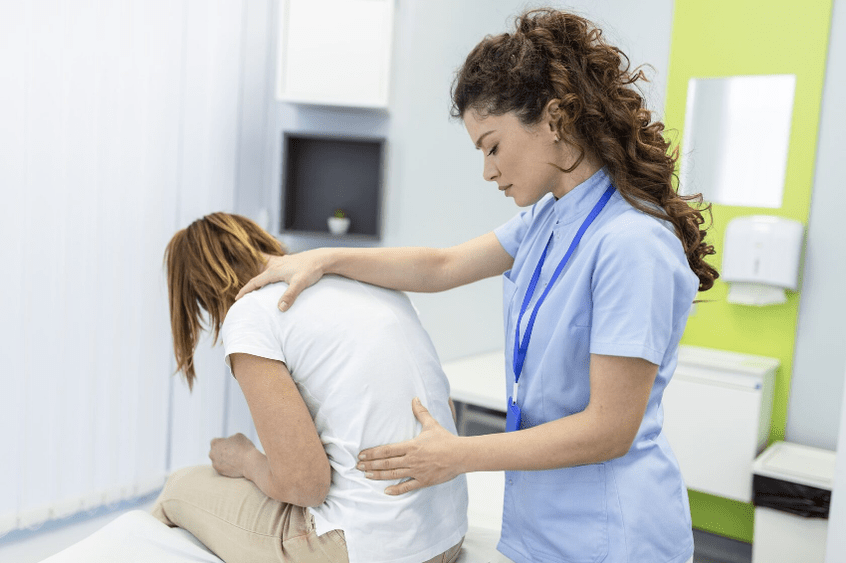
Often the cause of pain is simply hypothermia, which affects the largest nerve in the human body, the sciatic nerve. In addition, against the background of hypothermia, it can be compressed, causing acute pain. Other factors that can trigger attacks:
- physical inactivity;
- excessive nervous tension;
- hard manual labor;
- damages and injuries.
Lower back pain can occur with urolithiasis, they are accompanied by pain. They are also characteristic of many sexually transmitted diseases. Lumbar pain in women is not always a medical condition. It is a physiological norm if it occurs before menstruation or at the onset of menopause. In these cases, the condition is not dangerous and can be controlled using pain relievers. With all the listed pathologies, moving, bending or doing any work at home is difficult.
Spinal disease
The main causes of lower back pain are various diseases, deformations and damage to the spine. The pain can be of a completely different nature. The intensity of their manifestation depends on many factors and varies greatly depending on the part of the spine affected. The most common types of pain observed are:
- periodic;
- local or local;
- pull or squeeze;
- burning and cutting;
- take a shot.
The intensity of symptomatic manifestations may depend on stress, sitting in an uncomfortable position in a chair, sports and physical activity. The discomfort increases when you stand or sit awkwardly. When muscle fibers contract, low back pain is observed and the entire area becomes painful. When you have such pain, movement will be stiff, symptoms spread down the back of your thighs and can spread to your calves and even your feet. Much depends on the type of disease and its nature. Pathology must be treated by a specialist.
Intervertebral hernia
Intervertebral hernias in the lumbar region often form with osteonecrosis at a later stage of development. They usually cover mainly the lumbar region, lower back and are formed between the 4-5th vertebrae, as well as in the sacrum region. The pain syndrome in this case causes discomfort, is invasive, is associated with nerve root damage and the occurrence of weak blood circulation. The pain is similar to the pain that occurs with radiculitis and is enhanced when you stand or sit in an uncomfortable chair. If the herniation is large, it will compress the spinal cord, the patient will lose sensitivity and, in complicated cases, may become paralyzed due to herniation between the discs.
You can understand what is worrying you about intervertebral hernia through the appearance of the following stages:
- inability to stand without support on a chair or other surface, this is due to increased load on the intervertebral discs;
- lying on the stomach is extremely uncomfortable;
- feeling of stiffness in the back;
- it is very difficult to bend forward;
- Inability to bend the back due to pain that impedes movement.
Hernia treatment is performed conservatively and surgically. The appropriate method is determined depending on the patient's condition. Conservative treatment in severe cases is ineffective.
Rachiocampis
With a small curvature, pain does not appear. A feeling of fatigue may occur, and the patient may want to spend more time lying down because the pain becomes stronger when standing or sitting. Various neurological disorders occur with second-degree malformations. At this stage, pain occurs, which can manifest itself in moderate and moderate intensity, present on the left and right sides. As the disease progresses, the discomfort increases during the day, in severe forms it becomes unbearable and is not relieved by local and systemic analgesics. It is difficult to completely eliminate the manifestation, the curvature can be cured quickly.
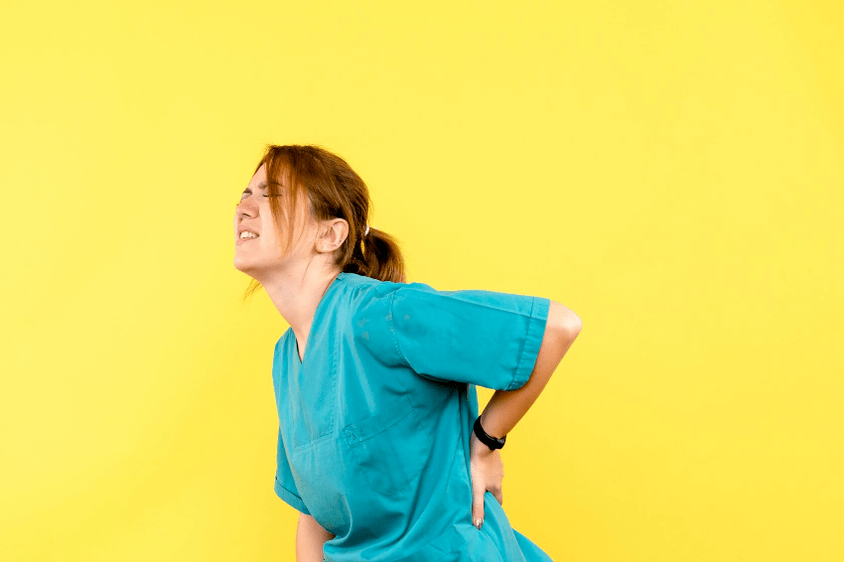
Osteoporosis
This disease usually occurs in men and women over 50 years old. The pathology is characterized by rapid loss of bone tissue. As a result of such loss, fragility occurs, the vertebrae become less strong and can be damaged even by minor injuries, physical exertion or heavy lifting. The patient only bends down when feeling uncomfortable and returns from the bent position with severe pain. For a person to pick up something from the floor, it is better to sit down and straighten your back, then stand up straight. If you sit down first, your risk of osteoporosis is reduced.
Pain in osteoporosis is not just caused by broken bones. Dangerous disease, can be used to register for disability group.
Spinal cord injury
The most common injury is a bruise. If mild, there is moderate discomfort. It tends to intensify during the day with movement, causing local swelling with hematoma and hemorrhage. Symptoms always increase with movement and exercise. In severe cases, the problem is not only painful, but can also be accompanied by neurological disorders, especially if nerve endings are involved in the process. It is impossible to completely eliminate the problem, it is not always possible to cure the consequences of injury even with surgery.
Soft tissue and kidney injuries
With soft tissue bruises, mild pain appears, which gradually subsides after the use of local anti-inflammatory compounds. The pain is always local, the bruised area is swollen and may bleed.
If combined with the described symptoms, left lumbar pain accompanied by blood in the urine, it means the kidneys have been damaged. The feeling of discomfort will be more intense, when the organs of the excretory system are seriously damaged, urination is impaired or impossible. Hematomas can occur in the lower back. The development of shock and life-threatening conditions is not excluded.
Spinal infection
Infectious lesions in the spine are more dangerous. Osteomyelitis can be:
- after surgery;
- post-traumatic;
- contact;
- there is blood.
In acute cases, the disease progresses at an extremely rapid rate. It is characterized by manifestations of increasing pain, intensifying during the day, accompanied by high body temperature and a very sharp deterioration in the general condition. The nature of the discomfort can be different: twitching, pressing, breaking. The attacks are very severe, hindering movement and forcing the person to freeze in one position because it is so painful to move. In chronic diseases, fistulas may appear with the formation of purulent fluid.
A rare but dangerous disease of the spine is spinal tuberculosis. Already at the initial stage of development, it causes deep and very strong pain below, reaching its peak after exercise. The gait of men and women becomes stiff. When the bone structure is destroyed, the nerve roots are compressed, the pain becomes burning and spreads to the lower part of the body.
With a spinal epidural abscess, the pain is quite deep, very strong, accompanied by chills and muscle tension. As it progresses, radicular syndrome becomes increasingly severe, paralysis occurs, and the functioning of the pelvic organs is disrupted.
Muscle damage
Uncomfortable pain in the lower back can occur after physical activity, weight lifting or intense exercise. It also manifests itself when in a prolonged static position with tension in the lower back and gluteal muscles.
With such damage, discomfort manifests itself less at rest and after rest, after applying warming ointment. Muscle damage or myositis occurs not only due to infection. It can be provoked by stress and hypothermia of the body, severe poisoning and metabolic disorders. This condition is often accompanied by pain.
Myofascial syndrome
Myofascial syndrome is classified as a painful condition in which lower back discomfort is associated with painful muscle tension. During an attack, trigger points will appear on the affected area. The source of pain is the muscles and connective tissues. To treat this pathology, experts prescribe painkillers, nonsteroidal anti-inflammatory drugs and sedatives.
In some cases, it is prescribed to treat the disease using muscle relaxants with a central effect. Such remedies are designed to reduce tension, reduce irritation, and stimulate relaxation of the muscles involved in spasm, so that the person can bend. In some cases, specialists resort to blockade of points by injecting anesthetics.
Tumors of the spine and kidneys
Tumors of the spine and spinal cord are quite rare. The frequency of detection of these diseases is no more than 0. 5% of the total number of cancers diagnosed. Tumors can be benign or malignant. Depending on this, the prognosis varies significantly.
With this disease, the typical symptom is lumbar pain. With benign causes, discomfort is reduced through the use of medication. If the tumor is malignant, treatment must be complex, usually requiring only surgery.
In addition, pain in the left lower back may be related to kidney cancer. It will have a distinct nature and may be painful, pressing, or broken. Discomfort increases over time and urinary disorders develop. Do not use steam or heat compresses on the affected area. It is possible to normalize the condition after removal of the formation.
What to do after acute back pain
If acute back pain appears momentarily, you can take control of the situation yourself. If possible, you should see a specialist and be examined to reduce the risk of recurrence.
It is necessary to urgently contact a specialist if the following symptoms occur:
- low back pain of any kind lasting for one week;
- Against the background of pain, body temperature increases;
- Discomfort manifests itself at the site of injury and previous damage;
- pain spreads throughout the body;
- Sensitivity of certain areas is lost.
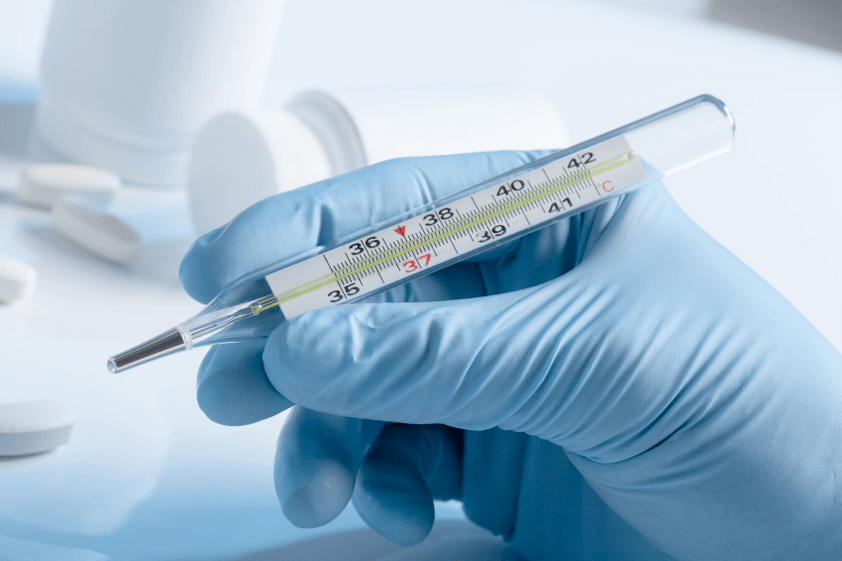
In these cases, the pain cannot be ignored. It is important to see a doctor as quickly as possible and begin treatment, otherwise the disease will progress.
Which doctor should I contact?
If you suspect the development of diseases of the musculoskeletal system, you should consult a traumatologist or neurologist. Experts will conduct a survey, do a physical examination and prescribe the necessary instrumental tests. If your back hurts suddenly, you can call an ambulance. You can use pain relief gel at home.
If you suspect low back pain is caused by kidney damage, you should see a urologist or nephrologist. You can also see a therapist. Any specialist will tell you what to do for lower back pain that manifests itself based on kidney disease, and will also prescribe additional examinations. Laboratory tests of the patient's blood and urine are required; they are necessary to confirm or refute the disease.
If lower back pain occurs sporadically in women and is related to menstruation or menopause, you should raise the issue with your gynecologist. The specialist will help you choose a treatment method that will eliminate discomfort. In cases where it is necessary to clarify the origin of the pain syndrome, you should visit a therapist, family doctor or general practitioner. The doctor will conduct an examination and determine the preliminary cause of the violation.
Diagnose
There are many factors that can cause low back pain, so even an experienced doctor cannot make an accurate diagnosis without an examination. The following methods are used as part of diagnosis:
- X-ray examination of the painful area;
- MRI;
- Ultrasound of pelvic and abdominal organs;
- general analysis of urine and blood;
- electromyogram.
If pain occurs due to pathologies of the genitourinary system or gastrointestinal tract, a colonoscopy examination may be necessary. If tumor growth is suspected in the body, a biochemical blood test will be performed.
Treatment
The necessary intervention regimen for the treatment of back pain is selected individually. The main principle is that treatment must be comprehensive, including symptomatic treatment and lifestyle changes. Treatment is chosen after the doctor determines the cause of the pain.
Regardless of the cause of back pain, all patients should follow these rules:
- Do not lift heavy objects;
- bend over and straighten your back when sitting;
- give up strenuous sports;
- If you are obese, you should lose weight;
- change sleeping place, create comfort;
- Regularly carry out minutes of physical education while sitting directly on a chair or armchair;
- light sports;
- Do not take saunas, do not go to saunas, do not take hot baths;
- Wear a support bandage (as prescribed by your doctor).
For diagnosed spinal pathologies, the treatment complex also includes the following recommendations:
- Medical influence. The use of analgesics, anti-inflammatory and decongestants is indicated. It can be prescribed to be taken orally and applied topically as a cream, gel or ointment to relieve pain.
- Lumbar blockade.
- Physical therapy. The patient is prescribed physiotherapy, massage, magnetic therapy and electrophoresis.
- Acupuncture, manual therapy, osteopathy.
In severe cases, when conservative intervention for spinal diseases does not bring results, surgical intervention will be performed.
The information in the article should not become the basis for self-diagnosis and treatment; It is provided for informational purposes only. You should not take any medication without consulting a specialist.
Trying to figure out how to get rid of low back pain and why your back hurts on its own is almost pointless. It can be of a different nature, depending on which effective method of impact is chosen. Self-medication for many pathologies is ineffective and dangerous, as it leads to aggravation of the condition.















































